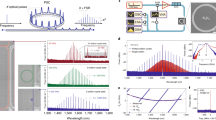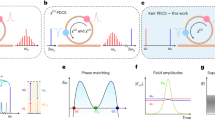Abstract
Self-organized solitons confined to an optical resonator would offer unique capabilities for experiments in communication, computation and sensing with light. Here, we report the observation of soliton crystals in monolithic Kerr microresonators—spontaneously and collectively ordered ensembles of co-propagating solitons whose interactions discretize their allowed temporal separations. We unambiguously identify and characterize soliton crystals through analysis of their ‘fingerprint’ optical spectra, which arise from spectral interference between the solitons. We identify a rich space of soliton crystals exhibiting crystallographic defects and we perform time-domain measurements to directly confirm our inference of their crystal structure. Soliton crystallization is explained by long-range soliton interactions mediated by resonator mode degeneracies, and we probe the qualitative difference between soliton crystals and the disorganized soliton liquid that would form in the absence of these interactions. Our work explores the physics of monolithic Kerr resonators in a regime of dense soliton occupation and offers a way to increase the efficiency of Kerr combs. Furthermore, the extreme degeneracy of the configuration space of soliton crystals suggests an implementation for an on-chip optical buffer.
This is a preview of subscription content, access via your institution
Access options
Access Nature and 54 other Nature Portfolio journals
Get Nature+, our best-value online-access subscription
$29.99 / 30 days
cancel any time
Subscribe to this journal
Receive 12 print issues and online access
$209.00 per year
only $17.42 per issue
Buy this article
- Purchase on Springer Link
- Instant access to full article PDF
Prices may be subject to local taxes which are calculated during checkout




Similar content being viewed by others
References
Kippenberg, T. J., Holzwarth, R. & Diddams, S. A. Microresonator-based optical frequency combs. Science 332, 555–559 (2011).
Diddams, S. A. The evolving optical frequency comb. J. Opt. Soc. Am. B 27, B51–B62 (2010).
Herr, T. et al. Temporal solitons in optical microresonators. Nat. Photon. 8, 145–152 (2014).
Herr, T. et al. Mode spectrum and temporal soliton formation in optical microresonators. Phys. Rev. Lett. 113, 123901 (2014).
Joshi, C. et al. Thermally controlled comb generation and soliton modelocking in microresonators. Opt. Lett. 41, 2565–2568 (2016).
Yi, X., Yang, Q.-F., Yang, K. Y., Suh, M.-G. & Vahala, K. Soliton frequency comb at microwave rates in a high-Q silica microresonator. Optica 2, 1078–1085 (2015).
Drake, T. E. et al. An octave-bandwidth Kerr optical frequency comb on a silicon chip. Adv. Opt. Photon. STu3Q.4 (2016).
Godey, C., Balakireva, I. V., Coillet, A. & Chembo, Y. K. Stability analysis of the spatiotemporal Lugiato–Lefever model for Kerr optical frequency combs in the anomalous and normal dispersion regimes. Phys. Rev. A 89, 063814 (2014).
Coen, S., Randle, H. G., Sylvestre, T. & Erkintalo, M. Modeling of octave-spanning Kerr frequency combs using a generalized mean-field Lugiato–Lefever model. Opt. Lett. 38, 37–39 (2013).
Coen, S. & Erkintalo, M. Universal scaling laws of Kerr frequency combs. Opt. Lett. 38, 1790–1792 (2013).
Yang, K. Y. et al. Broadband dispersion-engineered microresonator on a chip. Nat. Photon. 10, 316–320 (2016).
Okawachi, Y. et al. Bandwidth shaping of microresonator-based frequency combs via dispersion engineering. Opt. Lett. 39, 3535–3538 (2014).
Jang, J. K., Erkintalo, M., Coen, S. & Murdoch, S. G. Temporal tweezing of light through the trapping and manipulation of temporal cavity solitons. Nat. Commun. 6, 7370 (2015).
Leo, F. et al. Temporal cavity solitons in one-dimensional Kerr media as bits in an all-optical buffer. Nat. Photon. 4, 471–476 (2010).
Jang, J. K. et al. All-optical buffer based on temporal cavity solitons operating at 10 Gb/s. Opt. Lett. 41, 4526–4529 (2016).
Jang, J. K., Erkintalo, M., Murdoch, S. G. & Coen, S. Ultraweak long-range interactions of solitons observed over astronomical distances. Nat. Photon. 7, 657–663 (2013).
Coillet, A. et al. Azimuthal Turing patterns, bright and dark cavity solitons in Kerr combs generated with whispering-gallery-mode resonators. IEEE Photon. J. 5, 6100409 (2013).
Renninger, W. H. & Rakich, P. T. Closed-form solutions and scaling laws for Kerr frequency combs. Sci. Rep. 6, 24742 (2016).
Qi, Z., D’Aguanno, G. & Menyuk, C. R. Nonlinear frequency combs generated by cnoidal waves in microring resonators. J. Opt. Soc. Am. B 34, 785–794 (2017).
Malomed, B. A., Schwache, A. & Mitschke, F. Soliton lattice and gas in passive fiber-ring resonators. Fiber Integr. Opt. 17, 267–277 (1998).
Mitschke, F. & Schwache, A. Soliton ensembles in a nonlinear resonator. J. Opt. B 10, 779–788 (1998).
Schwache, A. & Mitschke, F. Properties of an optical soliton gas. Phys. Rev. E 55, 7720–7725 (1997).
Zajnulina, M. et al. Characteristics and stability of soliton crystals in optical fibres for the purpose of optical frequency comb generation. Opt. Commun. 393, 95–102 (2017).
Haboucha, A., Leblond, H., Salhi, M., Komarov, A. & Sanchez, F. Coherent soliton pattern formation in a fiber laser. Opt. Lett. 33, 524–526 (2008).
Amrani, F., Salhi, M., Grelu, P., Leblond, H. & Sanchez, F. Universal soliton pattern formations in passively mode-locked fiber lasers. Opt. Lett. 36, 1545–1547 (2011).
Haboucha, A., Leblond, H., Salhi, M., Komarov, A. & Sanchez, F. Analysis of soliton pattern formation in passively mode-locked fiber lasers. Phys. Rev. A 78, 043806 (2008).
Ashcroft, N. W. & Mermin, D. N. Solid State Physics (Brooks Cole, Belmont, USA, 1976).
Herr, T. et al. Universal formation dynamics and noise of Kerr-frequency combs in microresonators. Nat. Photon. 6, 480–487 (2012).
McDonald, G. S. & Firth, W. Spatial solitary wave optical memory. J. Opt. Soc. Am. B 7, 1328–1335 (1990).
Luo, K., Jang, J. K., Coen, S., Murdoch, S. G. & Erkintalo, M. Spontaneous creation and annihilation of temporal cavity solitons in a coherently driven passive fiber resonator. Opt. Lett. 40, 3735–3738 (2015).
Del’Haye, P., Beha, K., Papp, S. B. & Diddams, S. A. Self-injection locking and phase-locked states in microresonator-based optical frequency combs. Phys. Rev. Lett. 112, 043905 (2014).
Del’Haye, P. et al. Phase steps and resonator detuning measurements in microresonator frequency combs. Nat. Commun. 6, 5668 (2015).
Del’Haye, P., Diddams, S. A. & Papp, S. B. Laser-machined ultra-high-Q microrod resonators for nonlinear optics. Appl. Phys. Lett. 102, 221119 (2013).
Lee, H. et al. Chemically etched ultrahigh-Q wedge-resonator on a silicon chip. Nat. Photon. 6, 369–373 (2012).
Silver, J. M., Guo, C., Del Bino, L. & Del’Haye, P. Kerr superoscillator model for microresonator frequency combs. Phys. Rev. A 95, 033835 (2017).
Carmon, T., Yang, L. & Vahala, K. J. Dynamical thermal behavior and thermal self-stability of microcavities. Opt. Express 12, 4742–4750 (2004).
Liu, Y. et al. Investigation of mode coupling in normal-dispersion silicon nitride microresonators for Kerr frequency comb generation. Optica 1, 137–144 (2014).
Hansson, T. & Wabnitz, S. Bichromatically pumped microresonator frequency combs. Phys. Rev. A 90, 013811 (2014).
Skryabin, D. V. & Firth, W. J. Interaction of cavity solitons in degenerate optical parametric oscillators. Opt. Lett. 24, 1056–1058 (1999).
Wabnitz, S. Control of soliton train transmission, storage, and clock recovery by CW light injection. J. Opt. Soc. Am. B 13, 2739–2749 (1996).
Haus, H. A. & Huang, W. Coupled-mode theory. Proc. IEEE 79, 1505–1518 (1991).
Barker, J. A. & Henderson, D. What is ‘liquid’? Understanding the states of matter. Rev. Mod. Phys. 48, 587–671 (1976).
Egami, T. & Billinge, S. Underneath the Bragg Peaks (Elsevier, Oxford, UK, 2012).
Weiner, A. Ultrafast Optics (Wiley, Hoboken, USA, 2009).
Pang, M., He, W., Jiang, X. & Russell, P. S. J. All-optical bit storage in a fibre laser by optomechanically bound states of solitons. Nat. Photon. 10, 454–458 (2016).
Carusotto, I. & Ciuti, C. Quantum fluids of light. Rev. Mod. Phys. 85, 299–366 (2013).
Spillane, S. M., Kippenberg, T. J., Painter, O. J. & Vahala, K. J. Ideality in a fiber-taper-coupled microresonator system for application to cavity quantum electrodynamics. Phys. Rev. Lett. 91, 043902 (2003).
Beha, K. et al. Electronic synthesis of light. Optica 4, 406–411 (2017).
Acknowledgements
The authors thank D. Hickstein and K. Beloy for comments on the manuscript and K.Y. Yang and K. Vahala for providing the 16 GHz wedge resonators. This material is based on work supported by the Air Force Office of Scientific Research under award no. FA9550-16-1-0016. Additional support was provided by the NIST-on-a-Chip programme and the DARPA QuASAR and PULSE programmes. D.C.C. acknowledges support from the NSF GRFP under grant no. DGE 1144083.
Author information
Authors and Affiliations
Contributions
E.S.L., D.C.C., P.D.’H. and S.B.P. performed the crystal generation experiments. D.C.C. analysed the data, developed the model, and performed the numerical simulations. E.S.L. performed the cross-correlation experiments. D.C.C. wrote the manuscript. All authors discussed the experiments and the model and contributed to revision of the manuscript.
Corresponding author
Ethics declarations
Competing interests
The authors declare no competing financial interests.
Additional information
Publisher’s note: Springer Nature remains neutral with regard to jurisdictional claims in published maps and institutional affiliations.
Electronic supplementary material
Supplementary Information
Soliton crystals in Kerr resonators
Rights and permissions
About this article
Cite this article
Cole, D.C., Lamb, E.S., Del’Haye, P. et al. Soliton crystals in Kerr resonators. Nature Photon 11, 671–676 (2017). https://doi.org/10.1038/s41566-017-0009-z
Received:
Accepted:
Published:
Issue Date:
DOI: https://doi.org/10.1038/s41566-017-0009-z
This article is cited by
-
Genetic algorithm-enhanced microcomb state generation
Communications Physics (2024)
-
Strong interactions between solitons and background light in Brillouin-Kerr microcombs
Nature Communications (2024)
-
Parametrically driven pure-Kerr temporal solitons in a chip-integrated microcavity
Nature Photonics (2024)
-
Breaking the efficiency limitations of dissipative Kerr solitons using nonlinear couplers
Science China Physics, Mechanics & Astronomy (2024)
-
Two-photon imaging of soliton dynamics
Nature Communications (2023)



